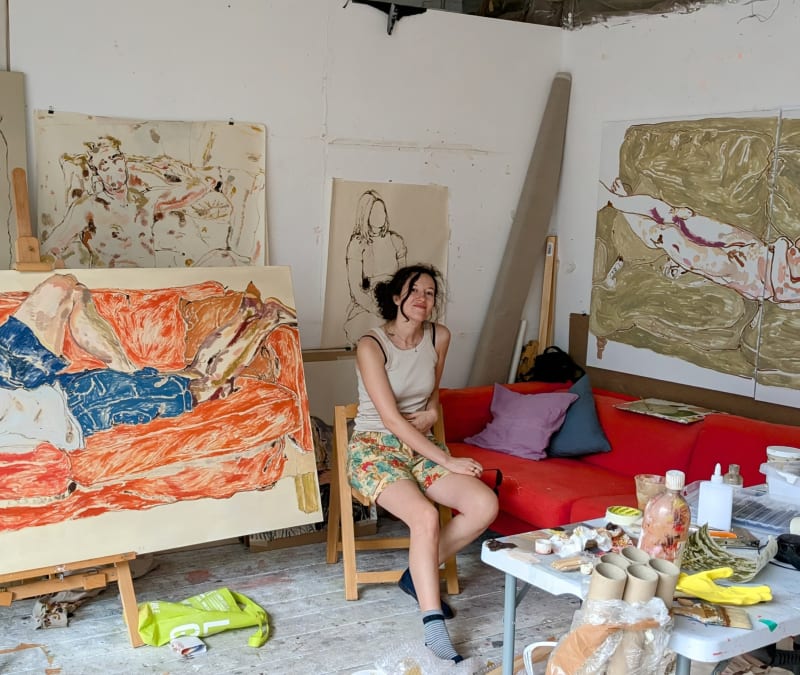Words by Kate Bryan
Morag Caister is a figurative painter who conjures emotive pictures that allow the viewer to move through external appearances to glimpse the interior landscape of her subjects. Caister is especially sensitive to the world around her and her work consistently reveals her preoccupation with the human condition. Even when painting a high stakes portrait commission, she prioritises pouring something of the sitter’s personality, mood and psychology above a conventional or literal likeness. As a consequence, the great success of her portraits is that they are first and foremost powerful pictures that say something about what it is to be human and ultimately what connects us.

Morag Caister, In Peacetime, 2024, Oil on Linen, 120 x 190 cm
Caister is one of those artists that cannot express what is in her pictures in any other way. Hers is a visual language that is sensitive in style and approach and yet at times feels urgent in its desire to be received and understood. Working with a loose but restrained mark making, Caister harnesses the power of empty space to contribute to her paintings. The passages of absence – whether untouched paper or half formed marks – have a valuable presence in her pictures. An intuitive draughtsperson, Caister’s lines cackle with energy, as if the force of the figure cannot be fully contained.
In her latest body of work Peacetime, Caister explores figures in repose, every one features a reclining body. The works are decidedly domestic in nature but the intimacy the artist achieves and the fluidity of her line mark them out as pictures with a quiet kind of grandeur. She somehow reminds us that this might be when we are most at one with ourselves and that there is a seriousness to healing power of being at rest. Although each one shares a repeated subject, the motif is pushed and pulled in different directions. In some the picture seems to collapse into itself, the setting becoming abstract and therefore all the more psychological. In others we feel as if we intrude upon a couple who can be completely at peace with one another in silence.

Morag Caister, Overview Effect 2, 2024, Oil on Linen, 100 x 200 cm
Although she orchestrated these sittings and the concept behind the exhibition, there is a wonderfully organic quality to the paintings because Caister paints in a deeply intuitive way. She has mastered the art of allowing herself to follow the direction the painting takes itself in, to not fight her instincts and to be comfortable with the discomfort of not knowing where the painting is going. She has described seeing an artwork even months after it was created and not really understanding where it came from. Ultimately, she must trust an rely on a kind of knowledge that is partly subconscious which allows her to consistently take risks in the way she makes her work.
Caister’s sensitivity extends to her use of colour. In previous years her palette was restrained with limited colour blocking and detail, allowing the primacy of her line to streak across the surface of the paper. In these new paintings, Caister demonstrates that she has an insightful versatility for colour, in some works rhythmic pastels combine to make an impressionist scene whereas in others she manages to allow figures to happily co-exist instead of being drowned out by a well-worn richly red sofa. It is also exciting to see patterns come into play and the realities of a home with dishevelled blankets and discarded clothes treated with a magnificently lazy kind of beauty. Although they might be described as mundane, the additions of these details is important as they remind us of the chaos of life which Caister holds at bay at the edges of her scenes.

Morag Caister, At Ease 3, 2024, Oil on Linen, 100 x 165 cm
These works appeal because they make us ache with desire to fall into our own sofa or bed, they are portraits of sanctuaries as much as people, and we instinctively feel that these spaces are anti-conflict, free of both external pressures and technology. These paintings express stillness and being as an important action. Whilst each scene is distinct and has the quality of a specific portrait, when taken as a group they remind us of our shared humanity. In Caister’s vision of peacetime, rest is not a luxury but a necessity and home is not a room but a feeling.


